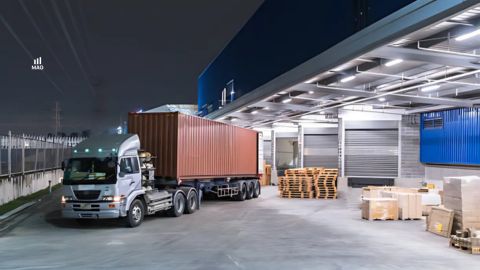
Bonded warehouse storage costs soar. Tariff uncertainty leads to a 60% price jump near US ports, hitting small sellers hardest.
Many Amazon sellers understandably seek ways to defer these added costs as tariffs intensify. Duty-deferred storage options, such as bonded warehouses, have emerged as a seemingly logical strategy to navigate this challenging landscape.
By temporarily storing imported goods without immediate tariff payment, sellers aim to gain flexibility and manage cash flow. However, this once promising tariff strategy now faces a significant hurdle: the escalating cost of bonded warehouse storage itself.
In 2025, bonded warehouse storage costs are experiencing a significant surge, potentially exceeding 1.5 to 4 times the rates of traditional warehouses. This dramatic increase effectively chips away at the very savings sellers hoped to achieve by delaying tariff payments.
Using bonded warehouse storage can potentially increase costs of selling on Amazon, so sellers must move beyond a singular focus on this option and further refine their overall tariff strategy. Instead of driving head-on into bonded warehouses, a more nuanced approach is required.
Bonded warehouse storage costs surge amidst tariff uncertainty
Featured on Maeil Business Newspaper, the rising cost of bonded warehouse storage is adding pressure to small and medium-sized enterprises (SMEs) in South Korea. These businesses are struggling with increasing logistics expenses as tariff-related uncertainties escalate.
According to the domestic logistics industry, bonded warehouse costs near US ports have surged, reaching 60% higher than standard warehouse fees. Bonded warehouses allow goods to be stored duty-free for up to five years, but the cost has ballooned due to elevated tariff rates and increased use as importers delay customs clearance.
The spike in bonded storage costs, around 15% post-tariff implementation, is driven by indecision over who will bear the tariff burden: the importer or the exporter. This hesitancy, shaped by international tariff negotiations, keeps goods in storage longer and raises expenses.
While logistics companies initially absorbed much of the added cost, this financial pressure is now shifting to the exporters. The ripple effect means higher costs for those holding the cargo, compounding the challenges of operating in uncertain conditions.
Large corporations with US-based subsidiaries are less affected, but SMEs without local presence are absorbing the full blow. For instance, secondary and tertiary vendors in the auto parts sector are now footing the bill for surging bonded warehouse fees triggered by a 25% auto tariff.
The instability has pushed some importers to halt shipments entirely, unsure of when or how much tariffs will apply. One electronics supplier has paused deliveries and moved stock to internal warehouses until tariff terms are clarified.
Others, like a heat exchanger exporter, have been cut off from key customers while awaiting clearer trade terms. Many exporters in sectors like automobiles and steel have pressed pause, citing the ongoing stalemate in tariff cost-sharing agreements.
GlobeSt"The rush for bonded space has been dramatic in places like Bayonne, New Jersey, where Accem Warehouse leased all 220,000 square feet of its bonded facility almost immediately after the tariffs were announced, before ships even reached port."
Trade policy shifts drive supply chain and logistics rethink
According to an article from Inbound Logistics, the global trade landscape in early 2025 continues to be very unpredictable, as evolving policies are generating new difficulties for those who import goods.
This volatile climate has left many businesses scrambling to adjust their logistics and supply chain strategies. Among the most effective tools in this uncertain landscape is the bonded warehouse, now gaining renewed attention.
Understanding bonded warehouses
A customs bonded warehouse is a secure storage facility licensed by a country’s customs authority. Within these facilities, goods can be stored without the payment of import duties or taxes until they are officially released into the domestic market.
Goods stored in these facilities are considered “in bond” and can be held for an extended period. This storage can often last up to five years, depending on the specific regulations of the jurisdiction.
Bonded warehouses serve multiple important purposes for importers. They enable the deferral of tax payments and provide space for staging inventory near destination markets.
These warehouses also offer value-added services under customs supervision, such as kitting, labeling, or repackaging. The primary benefit is the ability to delay duty payments until the goods leave the facility.
Key benefits of bonded warehouses
- Tariff and Duty Management
Importers can delay paying customs duties and tariffs until the goods are needed, sold, or distributed further. This is particularly advantageous when tariff rates are high or subject to change. If duties decrease after import, shippers may benefit from the lower rate.
- Strategically Facilitating Re-Exports
Goods brought into a country by exporters but destined for another market can be stored without duty payment. When these goods are re-exported, they leave the country duty-free, a common practice in free trade zones and port cities.
- Inventory Optimization
Businesses that have lengthy production schedules or experience sales peaks at specific times of the year can utilize bonded warehouses as a temporary storage solution. Bulk imports can be stored in bond and released gradually as needed, helping to balance inventory levels and prevent supply disruptions.
The extended storage period also allows for flexible inventory management and tax deferral.
- Value-Added Services
Besides simply storing and handling goods, numerous bonded warehouses provide additional services. Under customs supervision, goods can undergo inspection, repackaging, relabeling, or even light assembly, allowing businesses to meet customer demands closer to the distribution point.
Disadvantages of bonded warehouses
- Complex regulations
Navigating customs rules, documentation, and audits can be intricate and time-consuming, requiring U.S. Customs and Border Protection approval.
- Limited eligibility
Not all goods qualify, and permitted activities vary by country.
- Storage fees
Long-term storage can become costly if turnover is slow.
- Fewer locations
Bonded warehouses are more specialized and less common than standard warehouses.
Types of bonded warehouses
Businesses have several options for storing imported goods, including public and private bonded warehouses, as well as non-bonded warehouses. Government entities own and manage public bonded warehouses, which guarantees secure storage under the direct oversight of customs authorities.
Privately owned companies run private bonded warehouses, but their operations remain subject to customs authority supervision. These facilities often provide specialized storage services for various goods, including restricted items like tobacco and alcohol.
Non-bonded warehouses, in contrast, are not subject to customs supervision. They are used for storing goods that have already cleared customs. Each type offers unique advantages based on specific storage needs and regulatory requirements.
Growing importance in today's trade environment
The global trade landscape has undergone significant shifts in the past five years. Events like the US-China trade war, Brexit, pandemic-related supply chain issues, and increasing international sanctions have created substantial uncertainty.
Bonded warehouses are playing an increasingly vital role in managing the import of goods. They optimize cost savings, streamline supply chain management, expedite delivery, and mitigate the administrative burden of exporting.
As of 2025, there are three key reasons why bonded warehouses are attracting more attention.
- Volatility from new tariffs
With frequent changes in tariff proposals, companies are using bonded facilities as a risk management tool. Goods in bond are not immediately affected by duty spikes, and duties are only paid upon export, allowing time to adjust sourcing or distribution.
- Shift in manufacturing hubs
International trade patterns are evolving with businesses shifting their sourcing from China to countries such as Vietnam, India, and Mexico. Bonded warehouses near key transportation hubs are essential staging points for this evolving global manufacturing landscape.
These warehouses support manufacturing by allowing duty-free processing of imported goods.
- Cash flow pressures
Increased interest rates and stricter lending have made holding onto cash more important for businesses. Bonded warehouses help with this by allowing companies to postpone paying duties, sometimes for a long time, which frees up money for their main operations.
Is a bonded warehouse a sound option for Amazon sellers
While the benefits are clear, bonded warehouses come at a premium compared to traditional storage options.
Costs may offset some of the savings from deferred duties, especially for sellers with lower-margin products. Choosing bonded storage should be weighed carefully, as this WarehouseQuote article has noted, against your product volume, margins, and long-term strategy when addressing tariff volatility.
FreightWaves"While customs bonded warehouses can offer a valuable tool for managing tariff exposure, they are not a one-size-fits-all solution."
Key factors for Amazon sellers to evaluate
- Extended Storage for supply chain resilience
Sellers can store products for up to five years. These warehousing solutions can provide a buffer against market uncertainty or allow waiting for potential decreases in tariff duties.
- Increased Storage Costs
Bonded warehouse rates can be significantly higher, ranging from 1.5 to 4 times the cost of traditional warehousing. This increased expense must be factored into profitability calculations.
- Limited availability can lead to supply chain disruptions
The amount of bonded warehouse space available in the U.S. is finite. Sellers need to assess the availability of suitable space in their desired locations.
If utilizing bonded warehouses appears to be a feasible option for an Amazon seller, an experienced Amazon agency can provide valuable assistance to navigate tariff uncertainty. These agencies possess expertise in navigating the complexities of international trade and logistics.






